Photos: Treasures of a Late Roman-Era Shipwreck
Trash to treasure
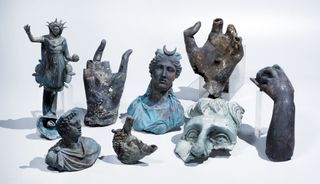
Fragments of bronze statuary were found in the harbor at Israel's Caesarea National Park. These 1,600-year-old treasures were once trash: Loaded onto a ship to be transported for recycling, they instead went down in a storm. Two divers discovered the wreck of the ship on the seafloor, and the Israel Antiquities Authority launched an archaeological study and salvage project.
Luna the Moon Goddess
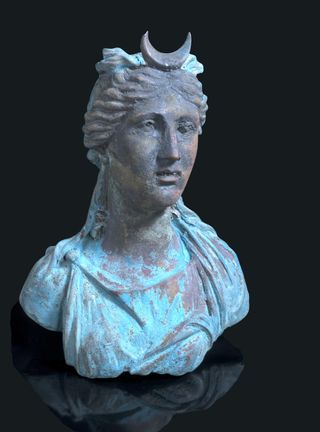
Among the statues found at the Israeli shipwreck site was this figurine of Luna, the moon goddess. The ship wrecked in the mid-300s A.D., based on the dates of coins found in the wreckage. This was a time when Constantine ruled the Western Roman Empire and soon triumphed in a civil war to united west and east and rule over both. He would convert to Christianity, end the persecution of Christians and sponsor the early Christian church. [Read the full story on the Roman-era shipwreck]
Sun God
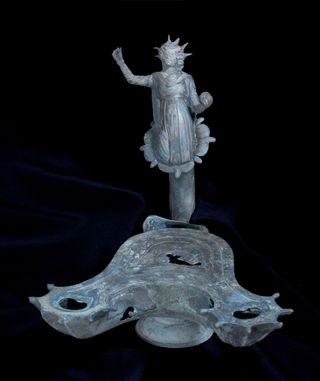
A lamp depicting the sun god Sol, found among the wreckage in Caesarea Harbor. Archaeologists reported that the ship appears to have hit stormy weather at the harbor entrance. Sailors attempted to cast their iron anchors overboard to stop the ship from drifting, but the effort failed and the ship smashed against the sea wall. [Read the full story on the Roman-era shipwreck]
Partial Face
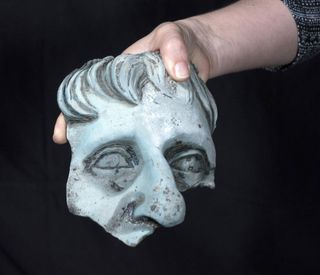
A fragment of a life-sized statue of a person. Metal statues are rarely found unless in shipwrecks, according to Israel Antiquities Authority archaeologists. They were typically melted down and recycled, the metal reused. The shipwreck 1,600 years ago in Caesarea Harbor sent these statues to the bottom of the sea, saving them from being destroyed. [Read the full story on the Roman-era shipwreck]
Slave Lamp
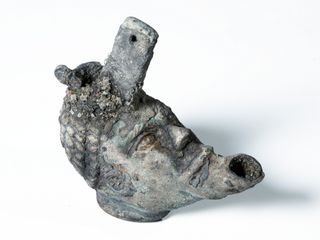
A lamp shaped like the face of an African slave was pulled from the shipwreck site in Caesarea Harbor. The artifacts were well-preserved by sand on the seafloor, Israel Antiquities Authority archeologists said. [Read the full story on the Roman-era shipwreck]
Rediscovered Faces
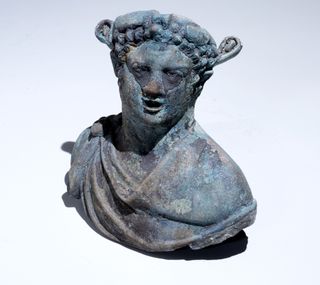
In 2015, divers stumbled upon a cache of gold coins near this shipwreck site, leading to speculation that other artifacts might be nearby. Two divers later happened upon the wreckage and alerted the Israel Antiquities Authority (IAA). According to the IAA, the divers will receive certificates of appreciation for alerting the authorities to the discovery, and will be invited to tour the country's Storerooms of the National Treasures. [Read the full story on the Roman-era shipwreck]
Lost anchor
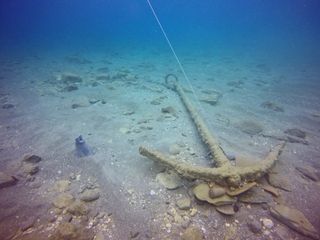
An iron anchor from the lost ship at the bottom of Caesarea Harbor in Israel. Sailors tried to prevent the ship from drifting into the seawall and rocks lining the harbor by casting these anchors overboard, but a preliminary assessment suggests the ropes holding the anchors broke and the ship was lost. [Read the full story on the Roman-era shipwreck]
Sign up for the Live Science daily newsletter now
Get the world’s most fascinating discoveries delivered straight to your inbox.
Chunks of coins
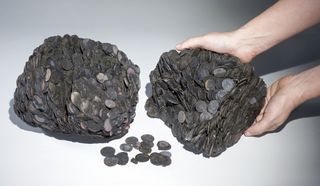
One of the oddest finds at the Caesarea Harbor shipwreck site were these two hunks of coins, melded together in the shape of the pottery vessels that once held them. Thousands of coins, together weighing 44 pounds (20 kilograms), depict the faces of the Emperor Constantine and his rival Licinius. Constantine defeated Licinius in 324 A.D. for control of the entire Roman Empire; he then had Licinius executed. [Read the full story on the Roman-era shipwreck]
Shipwreck equipment
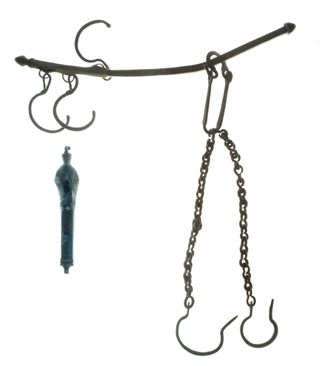
Hooks and chains found at the site of a 1,600-year-old shipwreck in Caesarea Harbor. This is the first marine find of such magnitude in Israel in 30 years, according to Israel Antiquities Authority archaeologists. Artifacts include pieces of the ship, statues, glass and pottery. [Read the full story on the Roman-era shipwreck]
Divers and treasures
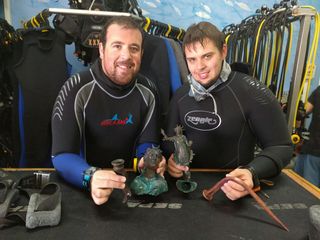
Divers pose with artifacts brought up from the site of a shipwreck 1,600 years old. The artifacts include a figurine of the moon goddess Luna and a lamp with a figure of the sun god Sol. [Read the full story on the Roman-era shipwreck]
Moment of discovery
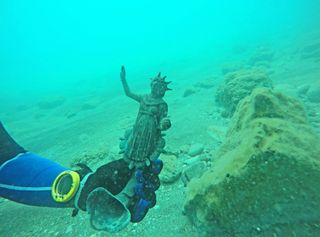
Divers Ran Feinstein and Ofer Ra'anan discovery statuary on the floor of Caesarea Harbor. This piece is a lamp depicting the sun god Sol. Feinstein and Ra'anan alerted the Israel Antiquities Authority to their find, and an archaeological examination ensued, uncovering many artifacts under the sand on the seafloor. [Read the full story on the Roman-era shipwreck]

Stephanie Pappas is a contributing writer for Live Science, covering topics ranging from geoscience to archaeology to the human brain and behavior. She was previously a senior writer for Live Science but is now a freelancer based in Denver, Colorado, and regularly contributes to Scientific American and The Monitor, the monthly magazine of the American Psychological Association. Stephanie received a bachelor's degree in psychology from the University of South Carolina and a graduate certificate in science communication from the University of California, Santa Cruz.











